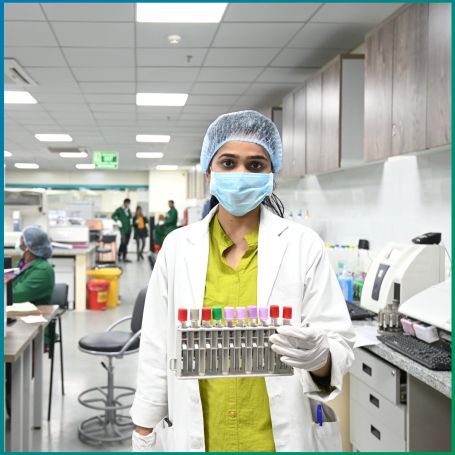
The BAL TC, DC test specifically refers to the evaluation of the total cell count (TC) and the differential cell count (DC) in the lavage fluid.


The Bronchoalveolar Lavage (BAL) is a diagnostic procedure that involves washing out the airways of the lungs with a sterile fluid to collect a sample of cells, fluids, and microorganisms. This sample is then examined under a microscope to help diagnose and monitor various lung conditions. These cell counts provide valuable insights into the types of cells present in the lungs, which can be indicative of infections, inflammation, or other pulmonary diseases.
1] Preparation: The patient is usually positioned lying on their back or side. A local anesthetic is applied to the throat to minimize discomfort, and mild sedation may be given to help the patient relax.
2] Bronchoscopy: A bronchoscope (a flexible tube with a camera) is inserted through the nose or mouth into the trachea and bronchi (the large airways). The bronchoscope allows the doctor to view the airways and ensure the correct location for lavage.
3] Lavage: Once the bronchoscope is in place, sterile saline solution is instilled into a specific segment of the lung. This fluid is then aspirated back into the bronchoscope to collect the cells and fluids from the lungs.
4] Sample Collection: The lavage fluid is sent to a laboratory where the cells, bacteria, fungi, and other microorganisms present are analyzed. In the case of the BAL TC, DC test, the sample is processed to determine the total cell count and the differential cell count of the fluid.
5] Post-Procedure Care: After the procedure, the patient is monitored for a short period as the sedation wears off. Some mild coughing or a sore throat may occur afterward, which is temporary. Most patients can return to normal activities within a day or two, but heavy physical exertion should be avoided for a short period.
1] Infections: Bacterial, viral, fungal, or mycobacterial infections of the lungs, including pneumonia, tuberculosis, and fungal infections.
2] Interstitial Lung Disease: Conditions like pulmonary fibrosis and sarcoidosis, where the lung tissue becomes inflamed and scarred.
3] Cancer: The test can help detect cancerous cells or metastatic cancer in the lungs, such as lung carcinoma, lymphoma, or sarcomas.
4] Chronic Inflammatory Conditions: Disorders like asthma, chronic obstructive pulmonary disease (COPD), and eosinophilic pneumonia can be identified based on the cell count and types of cells present in the lavage fluid.
5] Allergic Reactions: Conditions related to hypersensitivity or allergic responses can also show specific patterns in the BAL fluid.
Diagnopein offers advanced diagnostic services for the BAL TC, DC test with a focus on precision, safety, and patient comfort. The clinic is equipped with state-of-the-art bronchoscopy equipment and staffed by experienced pulmonologists and laboratory technicians who specialize in respiratory diagnostics. With a strong commitment to providing timely and accurate results, Diagnopein ensures that you receive a comprehensive evaluation of your lung health.
The clinic’s patient-centric approach means that you’ll receive personalized care, from consultation and testing to follow-up. The results of the BAL TC, DC test are interpreted by expert pathologists to provide a detailed analysis of your condition, ensuring that you have the information needed to make informed decisions about your treatment.
There is generally no special preparation, but you may be asked to avoid eating or drinking for several hours before the procedure. Inform your doctor about any medications or allergies.
Yes, the test can identify cancerous cells in the lungs, such as lung carcinoma or lymphoma, by examining the cell types and patterns in the lavage fluid.
It can help diagnose lung infections, pulmonary fibrosis, sarcoidosis, lung cancer, pneumonia, COPD, and other chronic lung conditions by analyzing the cell makeup of the lavage fluid.
While rare, risks include bleeding, infection, coughing, shortness of breath, or in extreme cases, pneumothorax (collapsed lung). However, these complications are uncommon.